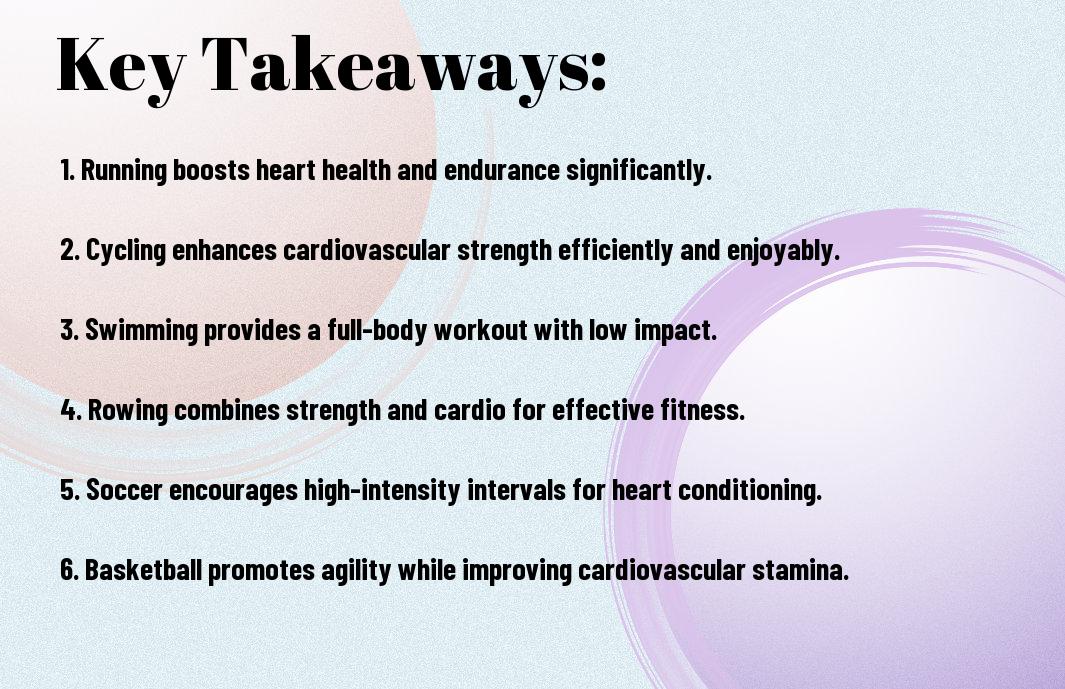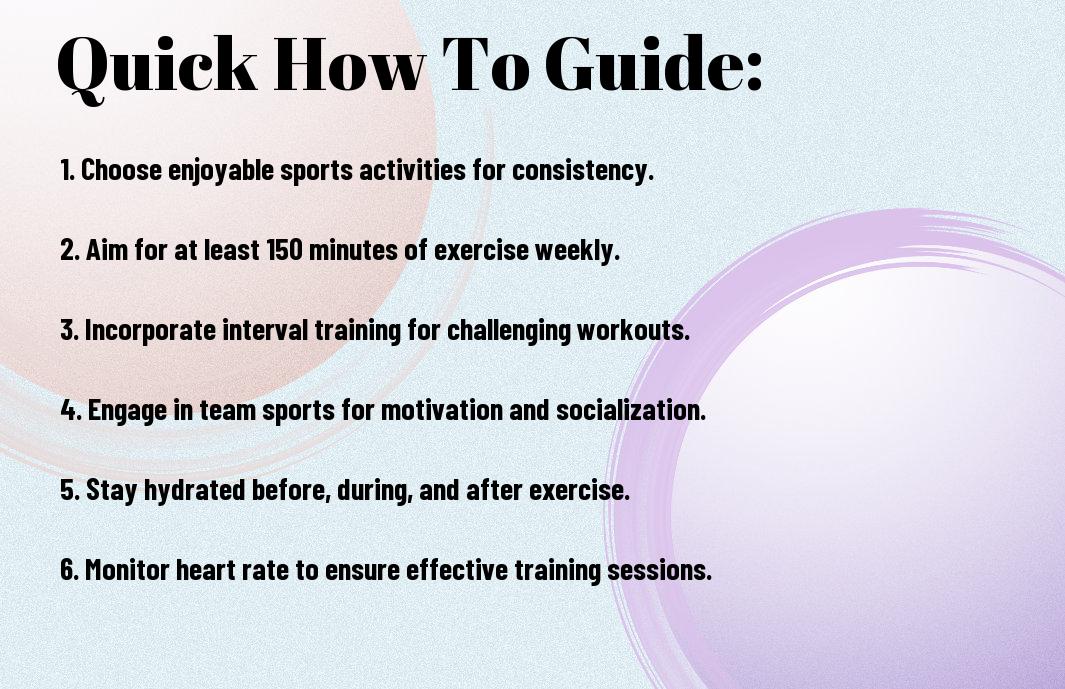Over time, engaging in sports that enhance your cardiovascular fitness can lead to significant health benefits. If you’re looking to improve your heart health while having fun, exploring various sports can be an excellent way to get active. This post will guide you through the top five sports that are particularly effective for boosting your cardiovascular endurance. For those interested in understanding more about the performance of these activities, check out this [Endurance Sports Ranked](https://www.topendsports.com/fitness/sports/endurance-espn.htm) resource for further insights.
Key Takeaways:
- Running: One of the simplest and most effective ways to enhance cardiovascular fitness, promoting heart health and endurance.
- Cycling: An excellent low-impact exercise that strengthens the heart while improving leg strength and stamina.
- Swimming: A full-body workout that is easy on the joints, benefiting cardiovascular health and muscle tone simultaneously.
- Rowing: A powerful cardiovascular exercise that engages multiple muscle groups, promoting heart efficiency and endurance.
- HIIT (High-Intensity Interval Training): A time-efficient way to improve cardiovascular fitness through alternating periods of high activity with rest or lower intensity.

Understanding Cardiovascular Fitness
For anyone looking to improve their overall health, understanding cardiovascular fitness is key. This aspect of fitness pertains to the efficiency of your heart and lungs in delivering oxygen to your muscles during physical activity. By engaging in exercises that elevate your heart rate, you not only boost your endurance but also enhance your body’s ability to perform daily tasks with ease.
Definition and Importance
To put it simply, cardiovascular fitness refers to your heart and lungs’ efficiency in supplying oxygen to your muscles. This form of fitness is significant because it directly impacts your overall health, physical performance, and ability to partake in daily activities. Achieving good cardiovascular fitness helps you maintain a healthy weight, manage stress, and even prolong your lifespan.
Health Benefits of Cardiovascular Exercise
About cardiovascular exercise, which includes activities such as running, cycling, and swimming, it offers numerous benefits that go beyond merely enhancing fitness. Engaging in regular cardiovascular workouts helps reduce the risk of chronic diseases, such as heart disease and diabetes, while also improving your mood and mental clarity.
Considering the array of health benefits, you will find that incorporating cardiovascular exercise into your routine fosters both physical and mental well-being. This type of exercise can lead to improved cholesterol levels, enhanced blood circulation, and increased lung capacity. Additionally, you may experience heightened energy levels and improved sleep quality, making it easier to navigate daily stressors. Embarking on a journey toward better cardiovascular fitness is a valuable investment in your overall health and lifestyle quality.

The Top 5 Sports for Cardiovascular Fitness
One of the best ways to improve your cardiovascular fitness is through engaging in sports. This not only makes your workout enjoyable but also challenges your body in diverse ways. Here are the top five sports that can significantly enhance your heart health and overall fitness level.
Running
An excellent way to boost your cardiovascular fitness, running can be done anywhere and at any time. This high-impact sport elevates your heart rate, strengthens your heart, and burns calories efficiently. Whether you prefer short sprints or long-distance running, it’s easy to tailor your routine to fit your goals.
Cycling
Against the backdrop of outdoor trails or indoor studios, cycling provides a low-impact workout that is highly effective for cardiovascular fitness. It allows you to build stamina and work on endurance while being easy on your joints, making it suitable for all fitness levels.
Consequently, cycling helps in improving your heart’s efficiency and increases lung capacity. Whether you choose to ride outdoors, on a stationary bike, or join a spinning class, you will benefit from a great cardiovascular workout that challenges your legs and core as well.
Swimming
Above all, swimming is an exceptional full-body workout that engages multiple muscle groups while significantly boosting your heart rate. It provides resistance, making your body work harder to move through the water, promoting both strength and cardiovascular endurance.
Further, swimming is particularly beneficial because it is low-impact, reducing the risk of injury while still effectively improving cardiovascular health. Different strokes can target various muscle groups, so you can keep your routines varied, fun, and engaging.
Rowing
Against the tide, rowing can significantly elevate your heart rate and build endurance. This sport effectively combines both strength-building and cardiovascular training, providing a balanced workout that can be done on water or with an indoor rowing machine.
Sports enthusiasts can take advantage of rowing’s dynamic nature. It requires coordinated movements from both the upper and lower body, meaning your heart and lungs work hard throughout the workout, resulting in an excellent cardiovascular challenge.
Basketball
For those who enjoy team sports, basketball offers an energetic way to enhance your cardiovascular fitness. The quick shifts in movement and high-intensity play combine to keep your heart rate elevated while improving agility and coordination.
To get the most out of basketball, participate in regular games or drills that incorporate running, jumping, and quick lateral movements. This not only helps in building endurance but also enhances your overall cardiovascular health while having fun with friends or teammates.
Comparing the Effectiveness of Each Sport
Keep in mind that the effectiveness of each sport varies based on your fitness goals, current fitness level, and preferences. The following table outlines key aspects of each sport to help you make an informed choice:
| Sport | Effectiveness |
|---|---|
| Running | High caloric burn and endurance |
| Cycling | Improved lower body strength |
| Swimming | Full-body workout with low impact |
| Rowing | Excellent for strength and endurance |
| High-Intensity Interval Training (HIIT) | Maximized fat burn in short periods |
Caloric Burn and Endurance
Around 700 to 900 calories can be burned per hour of running, while cycling usually burns about 600 to 800 calories in the same time frame. Swimming, depending on intensity, can use up approximately 400 to 700 calories. Each sport helps improve your endurance, with consistent practice enhancing your cardiovascular fitness over time.
Muscle Engagement and Overall Fitness
Above all, different sports engage various muscle groups. Running predominantly activates your lower body, while swimming recruits muscles across your entire body. Cycling is excellent for your legs, and rowing offers a comprehensive workout targeting both upper and lower body muscles.
Indeed, a well-rounded fitness routine should incorporate diverse activities to engage multiple muscle groups. For example, swimming not only strengthens your core and arms but also improves flexibility and joint mobility due to its low-impact nature. By diversifying your sports selection, you can achieve better overall fitness and reduce the risk of injury associated with repetitive strain from engaging in a single sport.
Tips for Getting Started in Each Sport
Not knowing where to begin can be daunting, but here are some tips to help you explore your chosen sport confidently:
- Research beginner classes or local clubs.
- Set aside regular time each week for practice.
- Find a workout buddy for motivation.
- Start slow to avoid injury and build endurance.
- Monitor your progress and celebrate small milestones.
Knowing how to ease into your sport will make your fitness journey more enjoyable.
Essential Gear
Behind every successful athlete is the right equipment. Invest in quality gear that enhances performance and comfort. For example, running shoes are crucial for runners, while cyclists need a reliable bike. Research what’s necessary for your sport and prioritize purchasing items that fit well and suit your level.
Setting Realistic Goals
Between setting ambitious targets and feeling overwhelmed lies the importance of breaking goals into smaller, actionable steps. Start with short-term objectives like exercising a few days a week before moving on to long-term aspirations. This balance will keep you motivated without feeling discouraged.
Gear your goals towards what you realistically can achieve within your lifestyle. Assess your current fitness level and schedule, then set attainable objectives that match your pace. By doing so, you’re more likely to adhere to your regimen, track your improvements, and ultimately foster a sense of accomplishment throughout your journey.
Safety Considerations and Injury Prevention
Your commitment to cardiovascular fitness should also include a focus on safety to avoid injuries that can sideline your progress. Ensuring you take the necessary precautions will not only enhance your overall experience but also help you achieve your fitness goals effectively and sustainably.
Common Injuries in Cardiovascular Sports
One of the most prevalent injuries you might encounter in cardiovascular sports includes strains and sprains, particularly in the knees and ankles. Other common injuries involve shin splints, tendinitis, and stress fractures. Being aware of these risks can better prepare you for preventive measures.
Strategies for Safe Practice
Between proper warm-up routines, cross-training, and paying attention to your body’s signals, you can significantly reduce the risk of injury. Integrating rest days and listening to your body when you feel fatigued are crucial for maintaining long-term fitness.
Plus, consistency in proper footwear and terrain is vital for injury prevention. Opt for shoes that offer adequate support specific to your sport and ensure they are not worn out. Establishing a balanced training schedule that incorporates strength and flexibility exercises will also fortify your muscles and joints, helping to mitigate potential injuries while allowing you to enjoy your cardiovascular activities. Taking these proactive steps can lead to a fulfilling and injury-free fitness journey.
Summing up
To wrap up, engaging in sports such as running, swimming, cycling, rowing, and basketball can significantly improve your cardiovascular fitness. These activities not only enhance your heart’s efficiency but also promote overall health and well-being. By integrating one or more of these sports into your routine, you can enjoy a fun and effective way to boost your stamina and endurance. Prioritize consistency, and you’ll likely notice positive changes in your fitness levels and overall energy.
FAQ
Q: What are the top sports that provide excellent cardiovascular fitness benefits?
A: The top 5 sports for cardiovascular fitness are running, cycling, swimming, rowing, and soccer. Each of these activities elevates heart rate and improves blood circulation, contributing to overall heart health and stamina. Running is great for building endurance, cycling offers a lower impact workout, swimming is a full-body exercise that is easy on the joints, rowing combines strength and cardio, while soccer provides a fun way to engage in interval training.
Q: How often should one engage in these sports to achieve optimal cardiovascular fitness?
A: To achieve optimal cardiovascular fitness, it is advisable to engage in these sports at least 150 minutes per week of moderate-intensity or 75 minutes of high-intensity activity. This can be broken down into sessions spread throughout the week, such as 30 minutes of running or cycling five times a week. It’s also beneficial to incorporate varied intensity and duration within those sessions to challenge the cardiovascular system effectively.
Q: Can anyone participate in these sports, or are there any specific considerations?
A: While many individuals can participate in these sports, it’s important to consider personal fitness levels, any pre-existing health conditions, and suitability for each activity. Beginners may start with shorter sessions and gradually increase intensity and duration to avoid injury. Consulting with a healthcare or fitness professional before starting a new sports regimen is advisable, especially for those with underlying health issues or those who have been inactive for an extended period.




